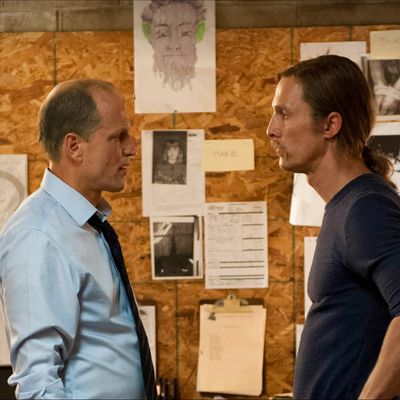
The impending True Detective season finale has provoked a level of fan intrigue and theorizing rarely seen for a miniseries. Within 121 episodes of Lost? Sure. Through 62 episodes of Breaking Bad? Or 78 episodes of Mad Men? Yes and yes. But there have only been seven episodes of True Detective so far. And yet there are theories upon theories, mountains of annotated screenshots, and enough mash-up videos and parodies to last all the way to next season. Going into Sunday’s finale, who really killed Dora Lange is perhaps the least important of all the questions the show still has to answer. Instead, these seven questions feel even more pressing.
1. What is Carcosa?
Is Carcosa a real place, like maybe where some of the ritualistic abuse occurs? Is it a state of mind, as in a dreamlike, drugged-out trance that some of the abuse victims recounted? Is it a name for a deity? Perhaps it’s another name for the “Him Who Eats Time” alluded to by the Tuttle’s former housekeeper in episode seven?
2. Is Audrey connected to the cult of the Yellow King?
We know Marty’s daughter Audrey made lewd drawings as a young child — but as we learned in later episodes, the drawings were also evocative of the ritualized rapes and murders. Is Audrey another victim? Are her drawings just a coincidence? She arranged her dolls in what looked like a gang rape — but might that just be remnants of overhearing her father talk about his work, or something a classmate told her at school?
3. Speaking of that, who exactly is the Yellow King?
I know, I know — it’s part of a collection of short stories about a play that makes its readers lose their minds. But what does it mean to the characters of TD?
4. Is Marty going to die?
Rust seems resigned to the looping agony of the flat circle, but Marty is not that philosophical — so last week when he said thank you to his ex-wife Maggie and she asked if he was saying good-bye, things felt very ominous. (“I think given the amorphous nature of the evil they’re pursuing, its historical roots in culture and government, they would have to be willing to die to fully pursue their absolute justice,” TD creator Nic Pizzolatto told BuzzFeed. “And they each understand this.”) More so than solving the mystery of who killed Dora Lange, Marty’s death would feel very final. Rust says the same things happen over and over; that’s true about a lot of things, maybe, but not about a main character dying.
5. Will we find out what happened to Rust between 2002 and 2012?
Rust’s biographical timeline has some major gaps in it, particularly between 2002 and 2007. What happened? Is this drunken, miserable Rust the end of his transformation, or just a middle point?
6. Are Detectives Papania and Gilbough good detectives?
They’ve been interviewing Marty and Rust for what feels like ages. Do they know that Rust and Marty lied about how Reggie Ledoux died? Do they know that Rust and Maggie had sex? Obviously they think something fishy is going on in Rust’s storage unit, but what is the extent of their suspicions, and why exactly are they reinvestigating this crime?
7. Why are drawing and painting so prominent?
One early sign that Rust was an against-the-grain kind of dude was that he sketched crimes scenes. We saw him gingerly shading a drawing of Dora Lange’s corpse, and we’ve seen his notebooks filled with sketches of the various “devil’s nests.” The burned-down church has two layers of paintings on the walls. (You can learn more about the set pieces here.) The police station has a painted mural. Audrey’s drawings alarmed her parents. (Well, her mother at least.) We see Rust flipping through Dora Lange’s heavily doodled-in notebooks. The drawing of the spaghetti-faced man. Contrast that with what we see in the more objective mediums of photographs and video: We see Dora Lange surrounded by men on horseback. The video of Marie Fontenot’s ritual torture. Photograph after photograph of murdered women. And, maybe significantly, Rust and Marty are being videotaped in 2007; the first shot we see of Rust is through the lens of a video camera. It’s not that the drawings depict anything less evil or vile than the photographs or videos, but perhaps they elicit different responses in the people who look at them. Drawings and paintings elicit compassion, curiosity, investment, connection. The photos and videos elicit horror, revulsion, fear. Does that mean we’re supposed to regard Rust and Marty with disgust, given that we’re sometimes seeing them through a video?
The show’s tendency toward spooky mythology and eerie tableaus has made the previous seven episodes feel very unsettled, which makes a resolution in this finale both more unlikely and more desirable. As Rust told us in episode three, “if the common good’s gotta make up fairy tales, then it’s not good for anybody.” Maybe what’s good for TD fans is not to make up an ending at all.




